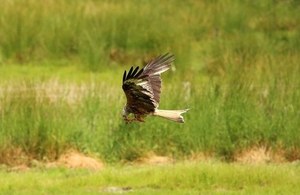Health and disease in relocated wild animals
Conference celebrates 25 years of the Zoological Society for London and Natural England’s partnership on the Species Recovery Programme.

Red kite © Andy Neale / Natural England
An international conference reviewing and celebrating the role played by translocation - transferring species to suitable sites - in the conservation of wild animals, is being held at the Zoological Society for London (ZSL) on 14 to15 May 2015.
The event marks a partnership between ZSL and Natural England, which spans a quarter of a century. During this time, 23 species including cirl bunting, field cricket and the dormouse have been given a better chance of survival because of translocation under Natural England’s Species Recovery Programme. In some cases this involved the reintroduction of species, such as the red kite, pool frog and large blue butterfly, which had previously been lost from England.
The Species Recovery Programme involves working with a wide range of partners to target conservation action at those species identified as most in need of help. Ongoing habitat loss has meant that many wildlife habitats are now severely degraded and fragmented. As a consequence, 500 species have been lost completely from England over the past 200 years, including the mouse-eared bat, the Essex emerald moth, and Ivell’s sea anemone.
Many of our native species are in decline, with more than 240 species now known on fewer than 5 sites including the reintroduced corncrake and short haired bumblebee. The scale of loss means that human intervention is sometimes needed to support the survival of species and to enable them to move between areas of habitat which can support them.
The conference focuses on the vital role of health surveillance to successful translocations, by increasing the success rate and minimising the risk of adverse effects on other species. The importance of taking disease risk into account when moving species from place to place is now widely recognised, and has been reflected in protocols and guidelines such as those published by the International Union for Conservation of Nature.
Dr Tim Hill, Chief Scientist at Natural England said:
You don’t need a crystal ball to see that translocations are likely to play an ever more important role in future. Our climate is changing rapidly and in some cases species will need a helping hand to cross hostile environments to reach areas where populations can remain viable.
While many challenges remain, we are learning more about this complex subject all the time – and we are in a far better position to meet these challenges than we were 25 years ago.
For further information see:
- the symposium ‘Health and Disease in Translocated Wild Animals’, on ZSL’s website
- the Species Recovery Programme offers targeted conservation action for species most in need